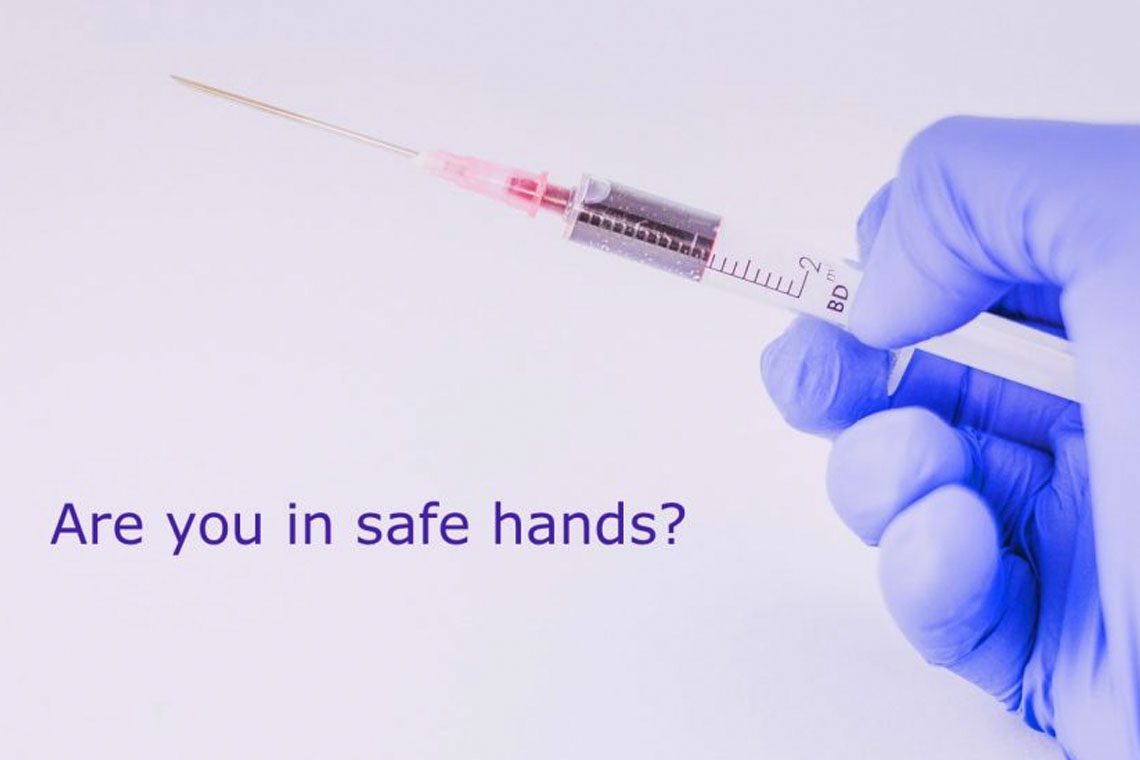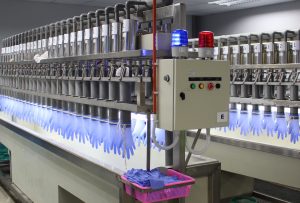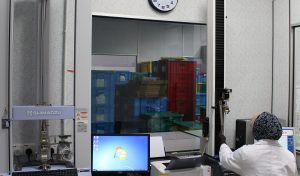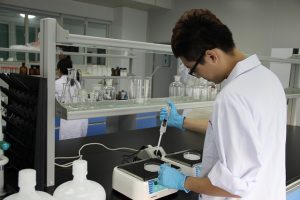
Medical gloves for single use
Why these standards?
In Europe, these standards are used to secure the glove wearer and the patient from cross contamination.
EN 455-1: Medical gloves for single use – Part 1: Requirements and testing for freedom from holes
EN 455-2: Medical gloves for single use – Part 2: Requirements and testing for physical properties
EN 455-3: Medical gloves for single use – Part 3: Requirements and testing for biological evaluation
EN 455-4: Medical gloves for single use – Part 4: Requirements and testing for shelf life determination
The following will in short terms describe each standard, and why it is important.
EN 455-1: Medical gloves for single use – Part 1: Requirements and testing for freedom from holes

This standard describes the test method in details how the gloves should be tested for freedom from holes. It is done via a watertight test, where the gloves are filled with 1 liter of water. After a specific time, the gloves are checked, and they must meet an AQL of min. 1,5 to prove compliance with this standard. That means only a certain level of pinholes is allowed in the gloves if it is CE labelled as a medical glove.
Why is EN 455-1 important:
This standard is important because we expect the glove we wear to be a barrier. If the gloves have a lot of pinholes, this barrier is compromised, and we are no longer protected from cross-contamination. Some people would be surprised to find out that there are some gloves that could have a pinhole. Since medical gloves are mass-produced, it is impossible to manufacture gloves without failures. Gloves are tested during production and before shipment (not all are doing that, but it can be required). It is important that the minimum level of pinholes are kept, as the risk of getting an infection through the glove will be increased with a higher AQL level (you can read more about AQL levels in the INFO – AQL).
Therefore, to ensure that the purpose of the standard is met the AQL cannot be higher than 1,5, if you want to have a safe glove.
EN 455-2: Medical gloves for single use – Part 2: Requirements and testing for physical properties
 In this standard, you will find the requirements for the size of the glove and the strength of the glove.
In this standard, you will find the requirements for the size of the glove and the strength of the glove.
This means exactly that you will find a table that describes the min. requirements for the length and the width of a surgical glove, and you will find another with the same information for examination and procedure gloves.
There are also requirements to the strength of the glove, or more precisely how much force needs to be used before the glove breaks – the Force at Break.
These requirements are different for different types of material, as well as it is different for surgical gloves and examination/procedure gloves.
The test method is described in details, and the gloves must be tested after manufacturing and after a challenge test.
Why is EN 455-2 important?
This standard is important to make sure that when you take out a Medium glove from a dispenser, that this glove would not be a size Small in another brand. It is also important that the gloves are manufactured with a certain length, enabling the whole hand to be covered.
The strength of the glove is important to make sure that the glove does not tear when you done the glove and if you use it for the intended purpose. The challenge test proves that the material under certain parameters will keep the strength.
EN 455-3: Medical gloves for single use – Part 3: Requirements and testing for biological evaluation
 This standard describes different areas that are important to make a biological evaluation on the gloves. It is the most complicated of the 4 standards, because there are many different test methods mentioned and different requirements.
This standard describes different areas that are important to make a biological evaluation on the gloves. It is the most complicated of the 4 standards, because there are many different test methods mentioned and different requirements.
A lot of manufacturers still believe this standard is only for latex glove, because here the latex protein level is covered, but because there are a lot of other issues covered by this standard, it is relevant for all types of Medical gloves.
There are various tests that must be made.
First there is the biological evaluation to see whether the glove will increase the risk of getting sensitized or is an irritant to the wearer. This is done by using 2 different parts of ISO 10993. The parts where the test methods are described are ISO 10993-5 and ISO 10993-10. Why these standards are used are based on the evaluation form ISO 10993-1, where a glove is found to be used on the surface of the skin, and in a shorter time.
The protein level of a latex glove should be tested using the modified Lowry test There are no requirements for a minimum protein level in this standard. Other test methods for protein level are mentioned in the annexes of this standard.
The powder level of a powder free glove should be tested using the method described in ISO EN 21171. The powder level of a powder free glove cannot exceed 2 mg/glove. If the powder level is above that, the glove is considered a powdered glove
Endotoxin level of a sterile glove can be tested. If you want to label your glove with a low content of endotoxin, the level must be below 20 EU/pair of gloves (EU=Endotoxin Units).
There are also labelling requirements in this standard, both specific for gloves, but reference to EN ISO 15223-1 is drawn.
When a manufacturer claims compliance to this part of EN 455, they must inform a user, if there are any chemicals added that are known to cause adverse health effects – upon request.
EN 455-3 may seem complicated, but it just covers what is needed to make sure the glove has undergone a proper biological evaluation before it is sold.
Why is EN 455-3 important?
It is important because we want to make sure that the glove does not make you sick, when you wear it. You should not be sensitized by using it, and irritants should be so low as possible.
There will always be a risk of reacting to your glove, this risk must be low. If you react to your glove, you need to be able to find out, which glove to use instead. Here the standard also helps you, because you can ask for a list of the chemicals used in the glove.
EN 455-4: Medical gloves for single use – Part 4: Requirements and testing for shelf life determination
 All glove has a certain shelf life. They need to be able to meet the first 3 mentioned standards during their shelf life. Therefore, this standard describes how to test the shelf life of a glove, and how it should be labelled. There are 2 test methods. The first one is the accelerated shelf life determination. The glove is undergoing different challenge tests and based on the results of the test the theoretical shelf life is calculated. When the shelf life determination is done based on the accelerated tests, the maximum years that can be claimed is 3 years. This test is normally made when a new glove is introduced. At the same time, it is a must that the real-time shelf life determination is started. This will take years to finalize – up to 5 years as this is the maximum shelf life for a glove.
All glove has a certain shelf life. They need to be able to meet the first 3 mentioned standards during their shelf life. Therefore, this standard describes how to test the shelf life of a glove, and how it should be labelled. There are 2 test methods. The first one is the accelerated shelf life determination. The glove is undergoing different challenge tests and based on the results of the test the theoretical shelf life is calculated. When the shelf life determination is done based on the accelerated tests, the maximum years that can be claimed is 3 years. This test is normally made when a new glove is introduced. At the same time, it is a must that the real-time shelf life determination is started. This will take years to finalize – up to 5 years as this is the maximum shelf life for a glove.
Why is this standard important?
It is important that when you use the glove, that you know whether it still provides you the expected protection. Since a glove degrades over time, it will only last for a certain period, when it is stored correctly.
You should not use the glove after the expiry date, as it may not give you the expected protection any more.
If you have questions you are more than welcome to contact me. I can either assist with a workshop to help understand the requirements better, or I can also assist in other ways, by setting up the requirements for your supplier.



